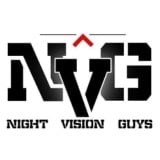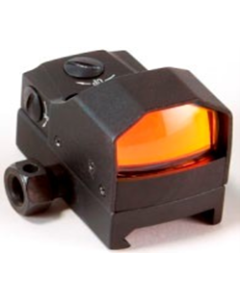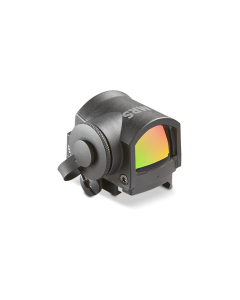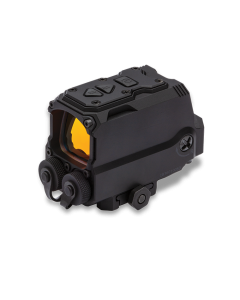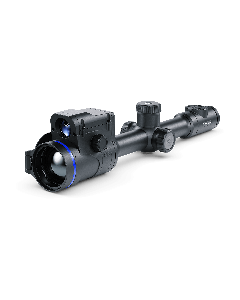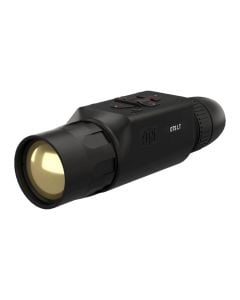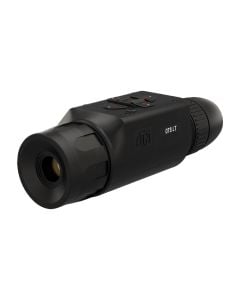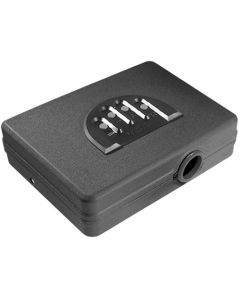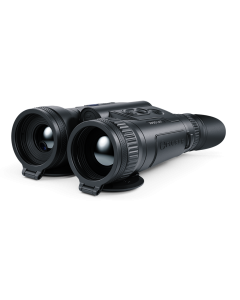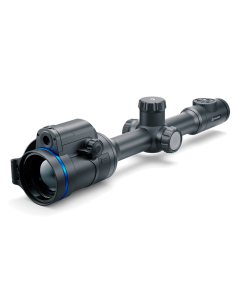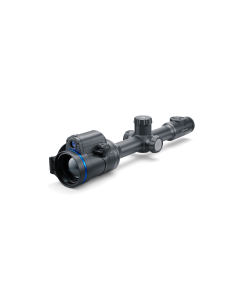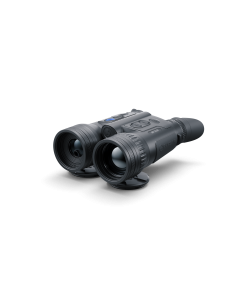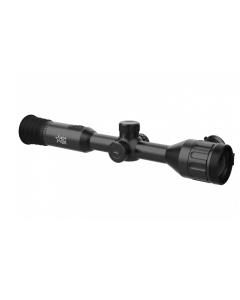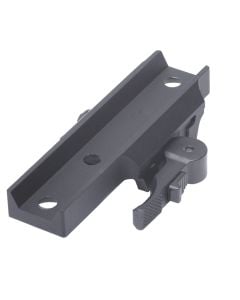Pulsar Trail XP50 Thermal Riflescope 1.6-12.8X50
From Night Vision Guys about Pulsar Apex XD75 3-6x52 Thermal Riflescope PL76475
Pulsar Apex XD75 is a new model in the Apex line. This Pulsar thermal imaging scope has a larger objective lens and as a result more senstivity. As with all other Apex scopes, you get amazing ergonomics, reliable build quality and great 50hz thermal imaging refresh rate. This Apex night vision scope is loaded with features. If you are a night time hunter, Apex XD75 will make a great companion. Thermal night vision is very effective against hogs and other animals hiding in the night. The bottom line Apex line should certainly be considered when shopping for a thermal scope.
From the market about Pulsar Apex XD75 3-6x52 Thermal Riflescope
Pulsar Apex XD75 3-6x52 Thermal Weapon Sight is a tough and reliable tool that is a perfect improvement to almost any shooter's weapon. These Pulsar thermal imaging scopes are made to be utilized for most outdoor quests. Providing the distance and thermal performance that many shooters want, the Pulsar Apex XD75 3-6x52 Thermal Weapon Sight delivers a simple functionality that can operate the device in practically any condition and setting. For many years, Pulsar has led the thermal imaging industry, and the Pulsar Apex XD75 3-6x52 Thermal Weapon Sight is a great example of their commitment to provide an ideal imaging system with top-rate quality. Pulsar Apex XD75 3-6x52 Thermal Weapon Sight is a great option for ensuring that you have gotten the best quality tool to take out on your next quest. So, if you're seeking top-quality effectiveness, the search stops here with the Pulsar Apex XD75 3-6x52 Thermal Weapon Sight.
Specifications for Pulsar Apex XD75 Thermal riflescope
- Frame Rate, Hz50
- Microbolometer resolution, pixels384x288
- Display typeOLED
- Display Resolution, pix.640x480
- Magnification, х3 ... 6
- Digital zoom, xgradual zoom 2х
- Objective LensF75/1.4
- Field of View,°, horizontal * vertical7.2x5.4
- Eye Relief, mm67
- Diopter adjustment, dptr.- 4…+ 3.5
- Range of detection, m (object (high*width = 1,7*0,5m)1600
- Power Supply, V4 ÷ 6
- Battery type2xCR123A
- External Power SupplyDC 8.4 ÷ 15
- Reticle typeVariable electronic reticles
- Windage & Elevation, 1 click, mm/ 100m20/ 20
- Shock-proofness, E0, joules (when used with rifled gun)6000
- Click range H/V, mm@100m4000/ 4000
- Operating Temperature,°С- 25 … +50
- Level of Protection (acc. to IEC 60529)IPX7
- Waterproofnessyes
- Dimensions, mm381x80x75
- Weight (without batteries), kg0.77
• 50hz refresh rate • High 640x480 resolution LCD display • 1,400yd detection range (human) • 3-6x magnification • One-shot zeroing with freeze function • 2x digital zoom • Manual, automatic, and semi-automatic calibration modes • Memorization of 3 zeroing parameters • 10 variable electronic reticles • IRIS technology, increased recognition and detection software • Rock, forest, and identification viewing modes • Hot white/ hot black viewing modes • Defective pixel repair feature • Video output • External power supply adaptable
Thermal Imaging
Please note that most thermal devices are built per order. It may take 3-5 days or more for your order to ship. If timely shipping is important to you, please, contact us to verify availability prior to ordering.
Thermal devices can produce various types of images. Some are color others are monochrome. In either case change in shade or color indicates temperature differences.
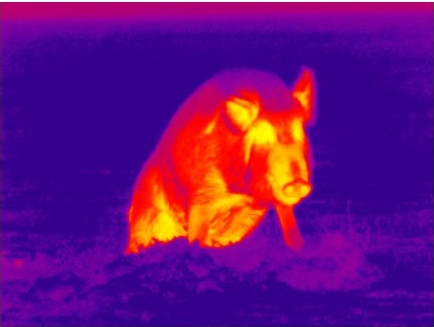

Here is how thermal imaging devices work...
A special lens focuses the infrared light emitted by all of the objects in view.
The focused light is scanned by a phased array of infrared-detector elements. The detector elements create a very detailed temperature pattern called a thermogram. It only takes about one-thirtieth of a second for the detector array to obtain the temperature information to make the thermogram. This information is obtained from several thousand points in the field of view of the detector array.
The thermogram created by the detector elements is translated into electric impulses.
The impulses are sent to a signal-processing unit, a circuit board with a dedicated chip that translates the information from the elements into data for the display.
The signal-processing unit sends the information to the display, where it appears as various colors depending on the intensity of the infrared emission. The combination of all the impulses from all of the elements creates the image.
There are a few key Manufacturers when it comes to thermal imaging.
ATN: produce such well knows devies as ThOR-HD thermal scope, BINOX-THD thermal binoculars, and OTS-HD thermal monocular.
FLIR/Armasight: the largest maker of consumer level thermal products is well knows for their full product line. Zeus thermal scopes, Q14 and Scout monoculars, Helios and Scout binoculars and many more.
Pulsar: a very popular brand for digital night vision and thermal imaging. Key products include Pulsar Trail and Apex thermal scopes and Pulsar Helion and Quantum thermal monoculars.
Seek: mobile device mounted thermal cameras are the main products of this brand.
Delivery Time and Manufacturing Process for Pulsar Apex XD75 3-6x52 Thermal Rifle Scope:
Most of our manufacturers do not keep products like Pulsar Apex XD75 3-6x52 Thermal Rifle Scope assembled on the shelf. Night Vision tubes are kept separate from the body of the unit. When the order is placed, the manufacturer starts the order processing and assembly process which includes the following:
- Order processing - we collect all the necessary information including address and phone numbers. We also make sure that our customer ordered the correct product for their needs and that the product can be exported by US law to the country of destination. In some cases a signed export compliance form is required.
- QC - in this step the manufacturer will inspect all individual parts which will be used to assemble the night vision device for any defects.
- Production & Assembly - during production, all the parts are put together. Night Vision tubes in inserted into the body of the unit and all the complex electronics for the device are connected. This process takes place in a special lab called the "clean room" as even a small speckle of dust can cause undesired optical effect.
- QA - one the night vision device is assembled, it goes through a rigorous testing process to make sure it meets all the expected specifications and all parts function as expected. For this most manufacturers have a special "dark room" designed to allow testing of the units without causing incidental damage to the night vision tube by exposure to bright light.
- Packaging - this is a key process as well. In most case your night vision device will be shipped to you directly from the manufacturer but sometimes needs to be sent to us first. In either case items need to be packaged securely to avoid any kind of damage during transportation.
- Shipping - as described above items will most of the time ship from the manufacturer. For most domestic orders (unless shipping to POB or AFB) a premium shipper like FedEx or UPS will be used.
Only by following the above steps can we along with our manufacturers bring you - our customer - night vision products of highest quality, However as you can understand the above process can take several days to complete. For example if your device fails QA, the entire process restarts. Also at QC stage a manufacturer may realize that the tube they have in stock has a defect and a replacement tube needs to be ordered. Due to the complexity of this process, it is prudent to expect 3-4 business days for production and handling of the purchased device. Keep in mind that this process is designed to guarantee your satisfaction with the night vision device of your choice. It occasionally possible to expedite the process for urgent orders but addional fees or other restrictions may apply.
From Our Community
Question
Can the apex xd-75 thermal rifle scope be used during daylight hunting hours as well as in total darkness
From Chris on Jan 18, 2016
Answer
Hi Chris. Absolutely yes. Apex XD-75 just as all other thermal scopes can be used in daylight. The only technology sensitive to light is the analog night vision. Thermal is a digital technology and will perform equally well in both conditions. Please let us know if you need any help picking the best thermal scope for your needs and budget.
Question
my objective is to use on a sbr 300 blackout what would you think my best selection would be for varmints an hogs
From Chris on Jan 18, 2016
Answer
Chris, how far are you planning to shoot? What is your minimum and maximum range.
Question
I have just purchased the Apex XD75 3-6X52 thermal scope, and would like to purchase an external battery pack for more field time. Would you send me price list on external battery backup packs. Lee Maxey
From lee k. maxey on Feb 05, 2016
Answer
Hi Lee. Currently Pulsar does not offer extended battery packs for Apex thermal scopes. Did you read somewhere that such devices exist?
Question
What generation is this thermal rifle scope? How will it hold up in the rain? Last, do you recommend a particular mini DVR recorder to combine with this scope for best recording results? Thank you.
From Ronald on Mar 10, 2016
Answer
Hi Ronald. When it comes to thermal riflescopes, there is no notion of generations. Thermal imaging devices are categorized by the parameters of their thermal core detector. Apex XD75 uses a 384x288 pixel core. With this riflescope you can detect a human sized target at around 1600 meters. For a recorder you should look at this model: http://www.nightvisionguys.com/sightmark-cvr640-digital-video-recorder-with-rail-mount
Question
Besides the zoom feature, what is the difference between the 75 and 75A.. It seems to me that the 75A has more zoom features and has the pic in pic feature.. but is less in price ? please explain.
From PtakNJ on Dec 14, 2016
Answer
Hi. You got it pretty much right. The only other difference is in the type of the display. XD75 is an OLED vs XD75A being LCD. Please let us know if you have any further question regarding these or any other thermal scopes.
Question
I read the precedent Q/A , my question is: what's the difference between OLED and LCD. Thank you Roberto
From Roberto on Jan 15, 2017
Answer
Hi Roberto. You can find a detailed write up on the difference between the two technologies here: https://www.cnet.com/news/led-lcd-vs-oled/
Question
What are people using for DVR recorders on this scope? also is there one on the market that mounts to the side rail of our gun
From Eric on Jan 27, 2017
Answer
Hi Eric. We suggest the DVR made by Sightmark (sister company of Pulsar). This DVR mounts on the rail as you requested: http://www.nightvisionguys.com/sightmark-cvr640-digital-video-recorder-with-rail-mount
Question
will the apex be discontinued when the trail becomes available ?
From Peter Sexton on Feb 22, 2017
Answer
Hi Peter. This particular model will be. There are a few new models coming out with a built in laser rangefinder. We will have them listed on the site within a week.
Question
I am new to this, but have always wanted to get some thermal imaging to attach to my AR-15 for hog and predator hunting. Pulsar seems to be the brand I want to go with. I just cannot figure out the differences between each of their products and I want to find out what is right for me. I have been looking at the Apex, the Trail, the Helion, the Quantum, and the Core. That might be all of their products... I know it is a lot to ask, but could you give me a break down of my options and what the differences are? Or why I would want to get one over the other? Also, I have no clue what these model numbers mean. Maybe you can help me with that as well? Please let me know what you think. Thanks
From Cody on Jun 10, 2017
Answer
Hi Cody. Do not feel bad. You are like majority of our customers. Thermal optics space is changing all the time and there is no need for you to stay current with every update. We are more than happy to help you pick the right device. We will need to know a few things about your hunting habits to make sure we suggest the right device. Please reply with the following: typical distance to target and types of game. Also, would be helpful to know if you feel that you need a range finder to use with your thermal scope.
Question
I want to use this thing to shoot coyotes or hogs at 100-300 yards. I would like to use this day or night, and I don't really need all the extraneous video, picture, smart phone stuff? Considering this.... Which would be the best pulsar night/day scope for me? Thanks.
From David on Sep 18, 2017
Answer
Hi David. There are two distinct technologies that Pulsar offers both of which can be used day or night. The two are digital night vision and thermal imaging. Fundamentally the two are very different. Night vision scopes will give you a black and white image as you would see with your own eyes. Thermal give you a heat map representation of the surrounding where cold and hot items stand out from the rest of the background. In some ways thermal imaging is superior and costs more in others night vision is better. For example with night vision it is easier to tell a coyote from your neighbor's dog. In a thermal scope they will both look virtually identical. On the other hand thermal scopes are harder to hide from and they will give you a longer detection range. It is probably best for you to speak to one of our product experts to further explore the specifics of your circumstances to identify the best device. Please let us know what time would be best for a call.
Question
Could you please tell me the best material to use for a target for sighting in my pulsar thermal,I use a hand warmer it worked great for a bullseye bit it's the back board that's the problem as I can't see where the point of impact is so I can adjust the sight
From James agnew on Nov 25, 2017
Answer
Hi James. I have a few ideas for you. Since you already have hand warmers, you can simply tape a paper target over it. Heat will be visible through the paper. You can also draw you target on hand warmers itself with a marker. Another method that people often use are beer caps. they throw them into an ice bucket and then nail them to the target. The cold stands out unless you are in a really cold climate.
Question
I'm looking to get a scope, let me refrase that. I'm looking for a scope to use during day and night so I don't have 2 switch out scopes constantly. I would like it to be able to be able to pick up body heat and be used even when there is heavy fog. I would like it to have a rangefinder as well. One that shows on screen and doesn't disappear when the crosshairs on on screen and be able to record video, with a good battery life.. would hate to have to stop hunting just cause of dead battery.. do y'all have anything lime this
From Melvin Mills Jr on Mar 20, 2018
Answer
Hi Melvin. There are several models of thermal scopes on the market that offer the rangefinder feature and most of them have extended battery options as well. The 3 big questions are: how far do you need to see, what weapon do you use, and what is your budget range. With those 3 parameters we will be able toboffer the right models.










